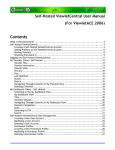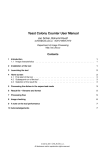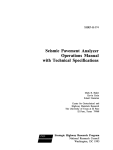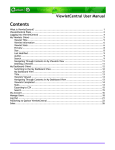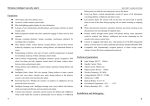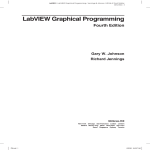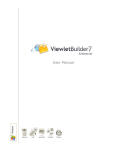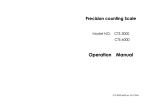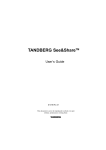Download WIDAM - WEB INTERACTION DISPLAY AND MONITORING
Transcript
WIDAM - WEB INTERACTION DISPLAY AND MONITORING
Hugo Gamboa and Vasco Ferreira
Escola Superior de Tecnologia de Setúbal
Campo do IPS, Estefanilha, 2914-508 Setúbal, Portugal
Email: {hgamboa, vferreira}@est.ips.pt
Key words:
Human computer interaction, web, monitoring system, client-server application.
Abstract:
In this paper we describe the design and implementation of a system called Web Interaction Display and
Monitoring (WIDAM). We have developed a web based client-server application that offers several services:
(i) real time monitoring of the user interaction to be used in synchronous playback (Synchronous Monitoring
Service) (ii) real time observation by other users (Synchronous Playback Service); (iii) storage of the user
interaction information in the server database (Recording Service); (iv) retrieval and playback of a stored
monitored interaction (Asynchronous Playback Service).
WIDAM allows the usage of an interaction monitoring system directly over a web page, without the need of
any installation, using low bandwidth comparatively to image based remote display systems.
We discuss several applications of the presented system like intelligent tutoring systems, usability analysis,
system performance monitoring, synchronous or asynchronous e-learning tools.
1
Introduction
There are several types of User Interaction Monitoring systems available on the market. We classify
them according to their principal usage.
Remote computer operation systems, allow the
control of the user interface of a remote machine from
anywhere on the Internet. Examples of these systems
are: Netmeeting (Microsoft, 2002), a tool freely included in all windows distributions that allows, between others services, the possibility to operate a
computer from a remote location (Remote Desktop
Sharing); The program Virtual Network Computing
from AT&T (Richardson et al., 1998)(Richardson and
Wood, 1998), which is available for several machine
architectures, enables independent operation systems
interconnection. The VNC was developed in an open
source effort and is freely available. The program
pcAnywhere (Symantec, 2002) from Symantec, is the
more known commercial remote desktop sharing application.
Interaction recording and display systems are capable of saving the interaction of a user, during the usage
of any type of application. This type of programs are
used to create training material, software simulations,
online presentations among others. Examples of these
programs are: ViewletBuilder (Qarbon, 2002) from
Qarbon, Camtasia (Weber, 2001) from TechSmith and
CamCorder from Microsoft Office.
Other interesting tools related to user interaction
monitoring systems are Java Observation, Scripting and Inspection Tool (JOSIT) (Chisholm, 2001)
and Widget Observation Simulation Inspection Tool
(WOSIT) (Geier et al., 2001). Both are software instrumentation tool’s for applications in Java and XWindows respectively. These tools are designed to:
1. observe the user’s manipulations of the target application’s GUI,
2. inspect states of the GUI, and
3. initiate actions on the target application’s GUI.
The X-Windows system (Scheifler, 1988) offers a
protocol that enables the communication of a user interaction via network. X-Windows system is transparent to the location of the user and always uses the
X-protocol to transmit and then process the user interaction in the graphics user interface of the program.
The X-Windows is associated to unix and linux operating systems, and can be used to lunch remote applications. The remote user needs to have a interface
emulator that understands the X-protocol. These emulators work in most of the operating systems, includ-
1
Figure 1: The WIDAM Architecture.
ing windows.
1.1
Our proposal
Our proposal, WIDAM, is a client-server application
for web pages monitoring, analysis and display. The
system can be called as a remote display system that
enables the real-time observation of the user interaction, offering four different services :
Figure 2: The services types provided by the WIDAM system
2
1. Synchronous Monitoring Service — real-time
monitoring of the user interaction;
2. Synchronous Display Service — real-time observation by other users;
3. Recording Service — storage of the user interaction information in the server database;
4. Playback Service — retrieval and playback of a
stored monitored interaction.
WIDAM, differs from the presented systems in several aspects. WIDAM allows the usage of a interaction recording system directly over a web page, based
on the Document Object Model (Hors et al., 2000)
(DOM) of the web page. The system works in a
normal web browser with java and javascript capabilities, without the need of any software installation.
WIDAM is a light weight networked application using low bandwidth comparatively to image based remote display systems.
In the following sections we will describe in detail
the WIDAM system. Section 2 mainly discusses the
system architecture, presenting the server and client
applications. The communication protocol developed
for the WIDAM system is presented in section 3. Section 4 contains an example of the WIDAM system
monitoring a game. In section 5 we discuss some
possible applications of the WIDAM system. We conclude presenting future developments of the system in
section 6.
2
System Architecture
The WIDAM Architecture is composed by a client
and server applications as depicted in figure 1.
The user accesses the WIDAM application via a
web browser that connects to the server. Then the
server sends back to the user a web page that is capable of monitoring and displaying the user interaction.
This page creates a connection to the server and selects one of the services provided by WIDAM. Then
the client and the server exchange messages using a
specific protocol.
The WIDAM system offers four services that enable the monitoring and display of the user interaction
in the web browser (see figure 2).
The Synchronous Monitoring Service is requested
when the user wants to send his interaction information in real time, and he is expecting that other users
will connect to the system and observe his interaction
at the same time. Every time the user interacts with
the browser, the server receives a notification message
in order to pass the information to the clients that requested the Synchronous Display Service.
The Synchronous Display Service is requested
by a user that wants to observe other user that is
presently sending his interaction information via the
Synchronous Monitoring Service. Every time the observed user interacts with the web page the event
is sent to the server and replicated to all the clients
that are connected via the Synchronous Display Service, and the interaction is simulated in the client web
browser.
The Recording Service is requested when the user
wants his navigation through the web page stored in
the server database. The events are sent in the same
way as in the Synchronous Monitoring Service, except, when the interaction information arrives to the
server, this information will be kept in the server
database.
The Playback Service is requested when a user
wants to view a recorded monitored interaction that
has been saved by a client (when this last one requested the Recording service).
When the client connects to the server it requests
one of the four available services. These services are
divided in two client modes: master and slave. The
master controls the interaction, the slave observe the
interaction. The client operates as master when he
requests the WIDAM system to monitor the interaction. The Synchronous Monitoring Service and the
Recording Service are the services in which the client
is in the master mode. The client operates in the slave
mode when he requests a service where the WIDAM
will play the interaction of some other user. The Synchronous Display Service and the Playback Service
are the services in which the client is in the slave
mode.
2.1
The client
The client works in any web browser capable of executing Javascript code and Java Applets, independent
of the operating system. When the users enters in a
page of the WIDAM system, an applet is launched.
This applet creates a socket connection that enables
the message passing from and to the server. The client
loads the html page and sends an handshaking message through the open socket, specifying which type
of service is requested.
The monitored html pages the clients request to be
monitored need to exist in the server. The socket connection can only be done to the server from where the
java applet was loaded.
In master mode service, the script sends a request
to the browser, asking for notification of the user interface events. These events are a sub set of the
events from the Document Object Model Events (Pixley, 2000). In table 1 we list the events captured by
the WIDAM system. Every time one of these events
occur, a message is passed to the server.
In the case of a slave mode service, the web
browser creates a virtual mouse pointer and waits
for messages from the server specifying which event
should be emulated in the web browser.
2.2
The server
The server machine is composed by two servers listening to different ports.
ID
0
1
2
3
4
5
6
7
8
Event handler
onMouseMove
onMouseDown
onKeyPress
onUnload
onMove
onSelect
onResize
onBlur
onFocus
Event cause
The user moves the cursor.
The user presses a mouse button.
The user presses a key.
The user exits a document.
The window is moved.
The user selects some text.
The window is resized.
The window loses focus.
The window receives focus.
Table 1: DOM events captured by WIDAM.
We used a http server (listening at port 80) to
wait for html pages requests. We used different http
servers like Internet Information System (IIS) from
Microsoft or the Apache http server from Apache
Software Foundation, a open source solution. The
html pages needed by the WIDAM system are passed
from the http server. The javascript code and applet
code needed for the communication, monitoring and
display operations, are also passed in the same manner.
We developed a Java server that listens for socket
requests at port 8001. This socket server is always
active and waiting for a request of a communication
channel. When a client asks for a socket connection,
the servers assigns a new socket and creates a thread
to process the communications with the new client.
The client sends a service request via a handshaking message. The state diagram of the server (see figure 3) specifies the operations performed by the server
in the different services types.
When the server receives a handshaking message
requesting the Synchronous Monitoring Service, the
server waits for data from the client and when the
data arrives, the server sends it to all slaves clients
that requested the interaction data. Similarly, when
the server is asked for the Synchronous Display Service, it waits for the data of the monitored user (master), and when it arrives the server sends the data to
the client. In the case of the Recording Service, the
difference to the Synchronous Monitoring system is
that the received data is stored in the database. In last
service, the Playback service, the server starts retrieving the requested information from the database and
creates a timer to schedule the data messages according to the intervals these messages had at the recording time, in order to correctly emulate the playback of
the interaction in the client.
3
Communication Protocol
The WIDAM protocol is composed by three types
of messages: Handshaking, Data and Terminate.
3
Field
Bytes
message ID
event ID
DOM-Object ID
relative position X
relative position Y
absolute position X
absolute position Y
other information
timestamp
1
1
1
2
2
2
2
4
4
Table 3: Data message.
Field
Bytes
message ID
timestamp
1
4
Table 4: Terminate message.
Figure 3: A state diagram of the server.
Field
Bytes
message ID
version
service type
entry ID
timestamp
1
15
1
20
4
Table 2: Handshaking message.
The Handshaking begins with the client sending a
message identifying the protocol version used, the requested service type, identification information, and
a timestamp. These two last items are used to select
the entry in the database where the information should
be recorded or retrieved. The version entry is of the
form: "WIDAM v0.2", indicating the version and
sub version of the protocol the client will use. The
timestamp entry is a value that counts the milliseconds since January 1, 1970, 00:00:00 GMT. In table
2 the structure and type of contents of the message
handshaking are presented.
The Data message is sent to the server when the
client is operating as master, and is sent to the client
when the he is operating as slave. The message is
composed by several information about the Document
Object Model event generated. The event ID is the
4
number associated to the generated event (see table
1). The document object model object ID is the number that identifies the object in the page that is connected to the event. The relative positions are the Xaxis and Y-axis displacements relative to the origin of
the DOM object. The absolute positions express the
position of the pointer from the origin of the page.
The other information field contains additional data.
In the case of an onKeyPress event the other information contains the ASCII value of the pressed key.
The time stamps indicates, with millisecond precision
the time when the event occurred. Table 3 lists all the
fields of the message.
The terminate message is sent by the client stating
that it desires to close the connection. The message is
composed by the message ID and the timestamp (see
table 4)
The time diagram presented in figure 4 shows the
exchanged messages between the client and the server
in the case of the Recording Service. The client sends
a handshaking message requesting the Recording Service. The client starts monitoring the web browser
and sends data messages, specifying the type of event
and other related information, each time a the user interacts with the web page. In the end of the navigation
the client sends a termination message.
In normal operation the exchanged messages are
data messages. The handshaking message and terminate message occur only once per established connection. We can approximately calculate the bandwidth
required by the protocol by measuring a data message and the frequency of the exchange of messages.
The messages are generated by input devices like the
keyboard and the mouse. A pointing is the source of
most of the messages. It sends events notification every time the mouse is moved. The pointing device
is usually sampled at 50 times per second (there are
some differences between operating system and types
Figure 6: Graph of the user interaction in the memory game.
The staring point is marked with ’o’. The pointer movements are marked along the line and the ’+’ mark the mouse
clicks. .
Figure 4: A temporal diagram of the protocol, in the case of
the service recording.
Figure 5: An example: the memory game.
of mouse but these values are very similar). We get
a value of approximately 1 kbytes/s (950 bytes per
second) as the maximum required bandwidth. This
value occurs in the worst case of the user being always
moving around the mouse (without any interruption
to click or read), which is not the typical situation.
Even at the maximum required bandwidth, the protocol doesn’t require more than a simple Internet phone
line connection.
4
Example
We used the WIDAM system in the task of monitoring the user activity while playing a game. The
objective of this example is to provide a web interface to collect computer interaction data from several
users in order to create a repository of computer interaction information. This repository have been used in
the study of users interaction characteristics.
The reason to select a game is that games require
more user interaction activity, producing more interaction events, like mouse movements, mouse clicks
or key presses, per second, that normal computer in-
teraction in web browsing, mail reading, or document
producing.
The selected game is presented in figure 5 and is
called the memory game. A person clicks in a hidden
image that reveals itself and then tries to match the
pair image that exist somewhere in the board. If the
match fails, both image become hidden again.
We developed two web pages in order to use the
WIDAM system. The first page is an Identification
page, where the user introduces his name and a personal number. This page serves only the purpose of
identification of the user, in order to several recorded
games be kept with the user identification information. There is no need to an authentication system,
since there are no security issues with the task of collecting user computer interaction information.
The second page is the game page that uses the entered information to call the WIDAM system, evoking
the Recording service and starts monitoring the user
activity while the user is playing.
Figure 6 shows a graph of a user interaction while
playing an entire memory game. The graph is produced by joining every sequential mouse movement
with lines and using a cross mark to indicate a mouse
click.
In table 5 we show a excerpt of the recorded interaction protocol. These are data messages (see table 3
where we omitted the Other Information field since in
this events it is empty.
5
Applications
The system can be applied in several tasks from education to e-commerce. We developed the system primarily as a support of an e-learning environment. A
teacher opens the WIDAM system and starts browsing a set of web pages. The students open at the same
time the application and observe the teacher navigation through the same set of pages. A student that
could not be present at the time of the lecture can ac-
5
EID
DID
RX
RY
AX
AY
TS
0
0
0
0
1
0
8
8
7
7
7
7
6
5
24
17
16
16
20
20
20
20
20
20
97
96
73
66
65
65
215
215
215
215
215
215
1023049291400
1023049291460
1023049291510
1023049291570
1023049291730
1023049291840
Table 5: Example of the recorded data from a user
playing the memory game. The abbreviations are defined in the WIDAM protocol: EID: Event ID; DID:
DOM-Object ID; RX: Relative Position in X; RY:
Relative position in Y; AX: Absolute Position in X;
AY: Absolute position in Y; TS: Time stamp.
cess to a recorded interaction of the teacher a follow
the steps performed during the class. Note that the
system is suitable for a distant lecture or for a live
lesson at a computer laboratory. Every student is at
the computer and watch at the teacher movements in
a web page while the teacher is verbally explaining
what is doing.
Another example in the education area, specifically
asynchronous e-learning, is application of the system
recoding the student interaction while attending an
web based lesson, for instance in an asynchronous
mode, reading some texts delivered by the teacher via
web. The system can support the study the lecturer
attention, try to guess what areas of the lecture he is
more interested or the type of contents that the lecture likes most. The analysis of the interaction could
be used by an Intelligent Tutoring System in order to
propose to the student the more appropriated contents.
We have already applied the system in simple monitoring of a user interaction activity as presented as
example in section 4. In studying the type of interactions performed by several persons we could record
their interaction for later playback and analysis of
their mouse movements, key presses and other user
interactions.
The system could be used in a similar way in web
usability tests by identifying the difficulty of a user
to find what he wants in a particular web page. The
WIDAM system could record the interaction of the
user and the interaction playback shows the trips of
the mouse pointer until the user reaches the desired
button or part of the web page.
In a costumer relationship management system,
WIDAM could be used in the same mode as in a elearning class, where a operator conduces the user
thought the WebPages where he found a difficulty or
wants an explanation.
In an e-commerce web site, the WIDAM system
could be used in other to gain comprehension in what
are the web page areas that focus the user attention,
and what types of navigation is typically performed
6
by the users.
These are several application examples that can be
expanded to several areas related to the web.
6
Conclusion
In this study, we have presented a human computer
interaction monitoring and display system, functioning on the World Wide Web. The system is composed of client server architecture and works in a web
browser. Considering similar applications, we have
found that our proposal is a new approach to this problem by being a web based application and by presenting a protocol that requires a relatively small bandwidth.
This system raises some computer ethical questions. The usage of the WIDAM system in a hidden
way may be considered as a privacy violation. We
consider that our main focus is applying WIDAM to
education and free of this ethic questions, but as future
work usage norms of the system should be created.
The project has been constructed under an open
source initiative in order to freely be used by other
programmers. We have opened a project account in
SourceForge where the code for installing the system
is available and where people interested in the growth
of the project can meet to share effort in enhancing
WIDAM, reporting bugs and give examples of application of the system.
We are considering some effort in improving the
present version of the WIDAM system.
The protocol can be easily compressed by using a
differential code in the coordinates or in the time values. Applying some compressing technique like LZW
or other will further compress the resulting interaction
information.
As stated before, the system can only be used in
pages that exist in the server. We would like to pass
this limitation by fetching the pages that the master
user is interested and then inserting the monitoring
code in both master and slave users.
The protocol could be extended to enable the
adding of comments to interaction. These comments
could be text positioned in the web page adding some
information to the navigation, or the comments could
be in a sound format in order to the recorded interaction be companied by a verbal explanation.
The access to the system is open in the sense that
no one needs to do an identity check. So any one that
knows where the system is working can start a recoding session or a playback of a recorded interaction.
As future work we think that a security layer should
be created with a list of users and privileges.
REFERENCES
Chisholm, M. A. (2001). JOSIT user manual. Technical
Report MP 98BVSR, The MITRE Corporation, Center for Integrated Intelligence Systems, Bedford, Massachusetts.
Geier, M., Chisholm, M. A., and Cheikes, B. A.
(2001). WOSIT user manual. Technical Report
MTR 01B0000014, The MITRE Corporation, Center for Integrated Intelligence Systems, Bedford, Massachusetts.
Hors, A. L., Hgaret, P. L., and Wood, L. (2000). Document
object model level 2 core. Technical report, W3C.
Microsoft (2002).
Netmeeting.
URL,
http://www.microsoft.com/windows/netmeeting/,
accessed November 2002.
Pixley, T. (2000). Document object model (dom) level 2
events specification. Technical report, W3C.
Qarbon (2002). Quick start guide to viewletbuilder. Technical report, Qarbon.com Inc., San Jose, CA 95113
USA.
Richardson, T., Stafford-Fraser, Q., Wood, K. R., and Hopper, A. (1998). Virtual network computing. IEEE Internet Computing, 2(1):33–38.
Richardson, T. and Wood, K. R. (1998). The RFB protocol.
Technical Report 3.3, ORL Cambridge.
Scheifler, R. W. (1988). The X-Window System Protocol.
M.I.T. Laboratory for Computer Science.
Symantec (2002).
pcAnywhere.
http://www.symantec.com/pcanywhere/,
November 2002.
URL,
accessed
Weber, B. (2001). Camtasia white paper: Video screen capture tool for windows. Technical report, TechSmith.
7







